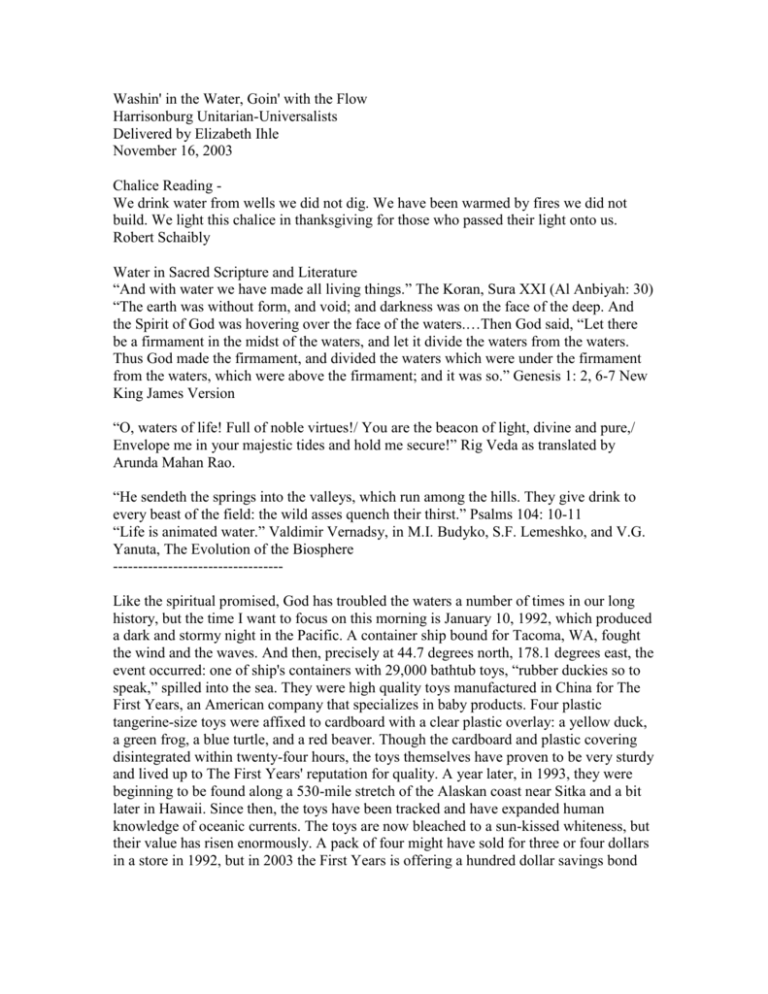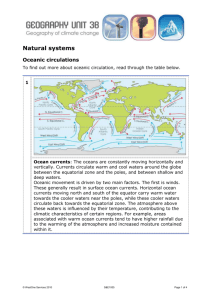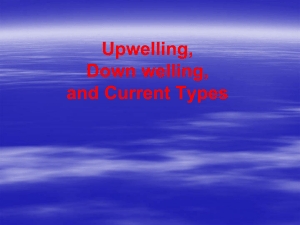Washin` in the Water, Goin` with the Flow
advertisement

Washin' in the Water, Goin' with the Flow Harrisonburg Unitarian-Universalists Delivered by Elizabeth Ihle November 16, 2003 Chalice Reading We drink water from wells we did not dig. We have been warmed by fires we did not build. We light this chalice in thanksgiving for those who passed their light onto us. Robert Schaibly Water in Sacred Scripture and Literature “And with water we have made all living things.” The Koran, Sura XXI (Al Anbiyah: 30) “The earth was without form, and void; and darkness was on the face of the deep. And the Spirit of God was hovering over the face of the waters.…Then God said, “Let there be a firmament in the midst of the waters, and let it divide the waters from the waters. Thus God made the firmament, and divided the waters which were under the firmament from the waters, which were above the firmament; and it was so.” Genesis 1: 2, 6-7 New King James Version “O, waters of life! Full of noble virtues!/ You are the beacon of light, divine and pure,/ Envelope me in your majestic tides and hold me secure!” Rig Veda as translated by Arunda Mahan Rao. “He sendeth the springs into the valleys, which run among the hills. They give drink to every beast of the field: the wild asses quench their thirst.” Psalms 104: 10-11 “Life is animated water.” Valdimir Vernadsy, in M.I. Budyko, S.F. Lemeshko, and V.G. Yanuta, The Evolution of the Biosphere ---------------------------------Like the spiritual promised, God has troubled the waters a number of times in our long history, but the time I want to focus on this morning is January 10, 1992, which produced a dark and stormy night in the Pacific. A container ship bound for Tacoma, WA, fought the wind and the waves. And then, precisely at 44.7 degrees north, 178.1 degrees east, the event occurred: one of ship's containers with 29,000 bathtub toys, “rubber duckies so to speak,” spilled into the sea. They were high quality toys manufactured in China for The First Years, an American company that specializes in baby products. Four plastic tangerine-size toys were affixed to cardboard with a clear plastic overlay: a yellow duck, a green frog, a blue turtle, and a red beaver. Though the cardboard and plastic covering disintegrated within twenty-four hours, the toys themselves have proven to be very sturdy and lived up to The First Years' reputation for quality. A year later, in 1993, they were beginning to be found along a 530-mile stretch of the Alaskan coast near Sitka and a bit later in Hawaii. Since then, the toys have been tracked and have expanded human knowledge of oceanic currents. The toys are now bleached to a sun-kissed whiteness, but their value has risen enormously. A pack of four might have sold for three or four dollars in a store in 1992, but in 2003 the First Years is offering a hundred dollar savings bond for each toy found on the coasts of Canada, New England, or Iceland. What started out as a commercial loss for The First Years has now turned into a marketing bonanza. So what do these toys have to do with this water service? It's the final one in a series of four that have focused respectively on earth, air, fire, and water. The rubber duckies and the other bath toys have been washed in the water and have gone with the flow. They serve as a useful introduction to the idea that we humans are washed in the water in our mothers' uteruses and use washing as purifying rituals in a number of cultures. We go with the flow with our tears, and water is often used as a symbol of emotions. Like the rubber duckies humans experience being set down in places we haven't always controlled and, as our lives have continued, we have taken journeys on the river of life about which we have never even dreamed. Like these particular 29,000 special rubber duckies, we as Americans have garnered more than our share of the world's attention. On the altar this morning are objects celebrating the four ancient elements of life and the directions. A rock for north and the earth, a votive for the south and fire, a feather and a pen for air and the East, and for water and West a meditation fountain. Byrd even gave us a little of our special “gathering of the waters” water to put into it. Although the elements and four directions are universal to all cultures, it's ironic that in our American culture water represents the West, as it is in our westernmost states that water scarcity is a very big issue. So let's begin at our beginnings. We know that life emerged from the waters. When the waters break, the child is born from them, just as the god of Genesis “parted the dark, primeval ocean and fashioned the earth, just as the first land creatures struggled up out of the tide.” Later here Genesis, the world re-emerges as pure once again after the Great Flood. We have used this coming out of the water in our rituals too. In the Jewish tradition, the Mikveh is a natural body of water in which one becomes ritually pure after immersion. It is used for conversion into Judaism, used before the High Holy Days or Shabbat; women who observe the Old Testament laws of family purity use it monthly and for a bride before her marriage. . It has been used also after divorce, rape, miscarriage, and abortion. The Mikveh is also used to make pots and pans kosher. Its purpose is not so much physical cleansing as it is spiritual. Archaeologists have uncovered Mikveh baths as early as 30 BC. The cleansing Mikveh is a way of changing the ordinary into the extraordinary. Immersion in the water symbolizes the death of an old life into the rebirth of a new one. The Jews do not have a monopoly on a cleansing ritual. We know that the Greeks and Romans have baths as well. The Christians have carried on this cleansing practice with Baptism that welcomes the child into the human family and the Christian tradition. For an adult, Baptism washes away the old life of sin and starts a new one in God's grace. Not all purifying baths today are associated with religion. A great day trip to a nearby one would take you to the Jefferson Pools in Warm Springs, VA. I didn't know until a couple months ago that Bath County, Virginia, home to the towns of Hot Springs and Warm Springs and the Homestead, is named Bath because of the healing waters that flow through there. It's said that people have used the waters for thousands of years, but whites established a bathhouse for men in 1818—and Jefferson was one of its first users-- and one for women in 1836. For a mere $15 these days a person can enter the Jefferson Pools whose temperature is 98.6 and spend an hour soaking in the bubbly and slightly sulphuric-smelling blue-green water. A rule of using the pools is that you do not talk or swim as you take the waters. You just float on one of those foam noodles. It's a place to be , a place of meditation and soul-cleansing, a secular ritual bath. The First Years' rubber duckies' “ritual bath” was a bit more violent and long-lasting than people's ritual baths are as the toys were pitched into the Pacific. They are certainly not the only things ever pitched en masse into the oceans. Among other massive dumps that have expanded our knowledge of currents are 150,000 bottles each with a message from King Neptune tossed into the Atlantic and Caribbean in 1959 by the Guinness Brewing Company as a publicity stunt and five containers of Nike sneakers and hiking boots—a total of 80,000 shoes in all that went overboard in the Pacific in 1990. However, for today I'm going to stick with the toys. The beauty of the rubber duckies for the study of currents is that they are plastic and float very nicely. But Curtis Ebbesmeyer, one of the leading scientists on oceanic currents, made a discovery about the rubber duckies that made the parallel to humans less of a stretch. When some of the toys washed up in Alaska, they had punctures in them, probably from being gnawed by sea otters. So Ebbesmeyer got new rubber duckies from The First Years, punched holes in them, and set them afloat. Even half full of water—like the human body is—they remained buoyant. Although the percentage of our bodies that is water varies by our age and sex, the average is about 60% or about forty liters. We, of course, have permeable skins rather than plastic for our shells. Oceanic currents are huge gyres shaped by prevailing winds, the Earth's rotation and bordering landmasses. The huge Pacific current is 14,000 miles in circumference and an object may take six years to make the circuit. But just like our human lives, objects in a current can get sidetracked. Storms can drive an object into another current, and that's what happened to some of the duckies. Some of them were blown into the North Pacific's counterclockwise Alaska Current, which can snag something from the Pacific Northwest and send it toward Siberia, or filter it though the teeth of the Aleutian Islands to be sucked through the Bering Strait and into the swirling belly of the Arctic. Now, eleven years later, some of the duckies have crossed the Arctic and have been caught up in the Labrador current that comes down our Atlantic Coast to the Outer Banks. Hence, scientists and the First Years are expecting a crop of rubber duckies to appear on the Atlantic coast, and their value to The First Years has risen considerably. Obviously, the rubber duckies are going exactly where the winds and currents take them, but humans have a bit more free agency. Even so, how many of us here in this room would have ever thought in our childhood or perhaps early adulthood that we would have wound up living a portion of our lives in the beautiful Shenandoah Valley? We didn't choose our parents or our childhood homes, but we may have chosen what job skills we developed or the people with whom we have made our family connections, and those factors may have led us here. Sometimes it's mind-boggling to think about our life journeys and the events that have brought us to our present circumstances. Our life currents may not have literally been water, but we have been tossed onto the sea of life and have made our way to the Shenandoah Valley. Our minds and spirits have roamed a bit too, and here as UUs we are fighting the religious currents. In that sense, we UUs are not “going with the flow” of Valley religious sentiment. The idea of being cast up in a place you never imagined or over which you may not have a lot of control is a stimulus for us Americans, especially those of us in much of the east who do not have to be continually worrying about water, to be especially grateful. As you probably already know, the earth's water has been continually recycled for millions of years—rain coming down into the earth, rivers, and oceans and then evaporation is an overly simple but useful description of the cycle, but the problem is that we have too many people and too much pollution to maintain a healthy stability. We have micro water problems and macro ones. You'll often see articles about local pollution in the Daily News-Record largely about agricultural runoff in our local streams and river. Folks in Bath County have formed the Cowpasture River Preservation Association to fight wastewater discharge permits into the Cowpasture, which is one of the state's most pristine waterways. A bit further away, developers in Florida want to move water from the northern part of the state, where most of the fresh water is, to the southern part where the bulk of the population lives. Across our continent, California is miffed these days because even the Bush Administration slashed the Colorado River allocations to the thirsty cities of southern California and now the state has to look toward building more desalinization plants to supply its needs. Desalinization, while a temporary solution, dumps back into the sea hot briny residue that causes marine pollution. Not only must Californians have enough to drink and grow their agriculture, but we also mustn't forget keeping their 560,000 swimming pools filled. As serious as these problems are for the maintenance of comfortable American life, these problems pale beside the worldwide water crisis. Only one-tenth of one percent of the world's water is potable. That might be sufficient for our needs except that water is so unequally distributed: the amount of water available depends on the location of water bodies and the amount of rainfall. On the one side are nations like Brazil, the former Soviet states, and Canada with an abundant natural supply; and on the other there are the arid zones of the Middle East and numerous African nations where nature is less generous. Some countries, like China, have plentiful water but experience stress due to mismanagement, pollution, and the demands of a large population. Today in almost every area of the world one chooses to look at there is a water problem—scarcity, depletion, pollution, lack of sanitation, failing rains due to global warming, big dam projects blocking up rivers, privatization, inequities of distribution, cross-border conflict, and profligate use and mismanagement. California officials are predicting by 2020 a water shortfall nearly equivalent to the state's current water usage. Eastern Europe and India face major river pollution. Sixty percent of U.S. industrial contaminants are injected straight into deep groundwater in the fond hope that none of it will ever bubble up into the water people actually use. During the 20 th century the world's population tripled, but water consumption grew sevenfold. Although domestic consumption grew more lavish, the major blame lies with a wasteful model of agriculture. Did you know that it takes six galleons of water to produce one cup of lettuce? Some folks have predicted that the struggle over water control will be for the twenty-first century what the struggle for oil was in the twentieth, and that's a scary thought. As our hymn this morning, “O Come, You Thirsty Longing Souls” points out, water and the growth it brings is essential to the maintenance of our lives, and its sufficiency for our 21 st century world is very much in doubt. We Americans are the “special” rubber duckies in the grand currents of life; we didn't ask to be born in an area rich in water and other natural resources, but we have been cast upon a shore of plenty anyway. We have had the luxury of being washed in a lot of water. Let us rejoice in our good fortune and go with the flow of thinking about the ways we can conserve our water and other resources so that others in the world will have more. Benediction - Let the waters flow through us in love and compassion, breaking the dams of indifference and setting free a flood of hope in a world leached dry by poverty, hatred, and greed. Go in peace!








